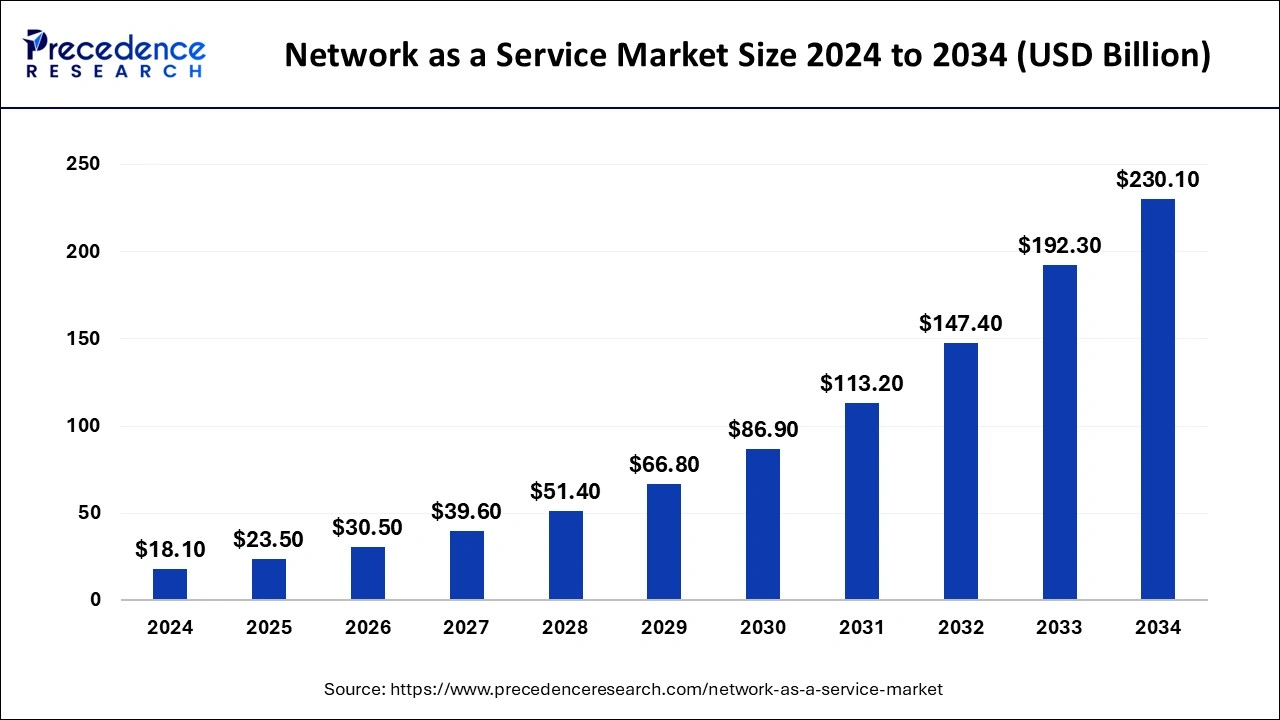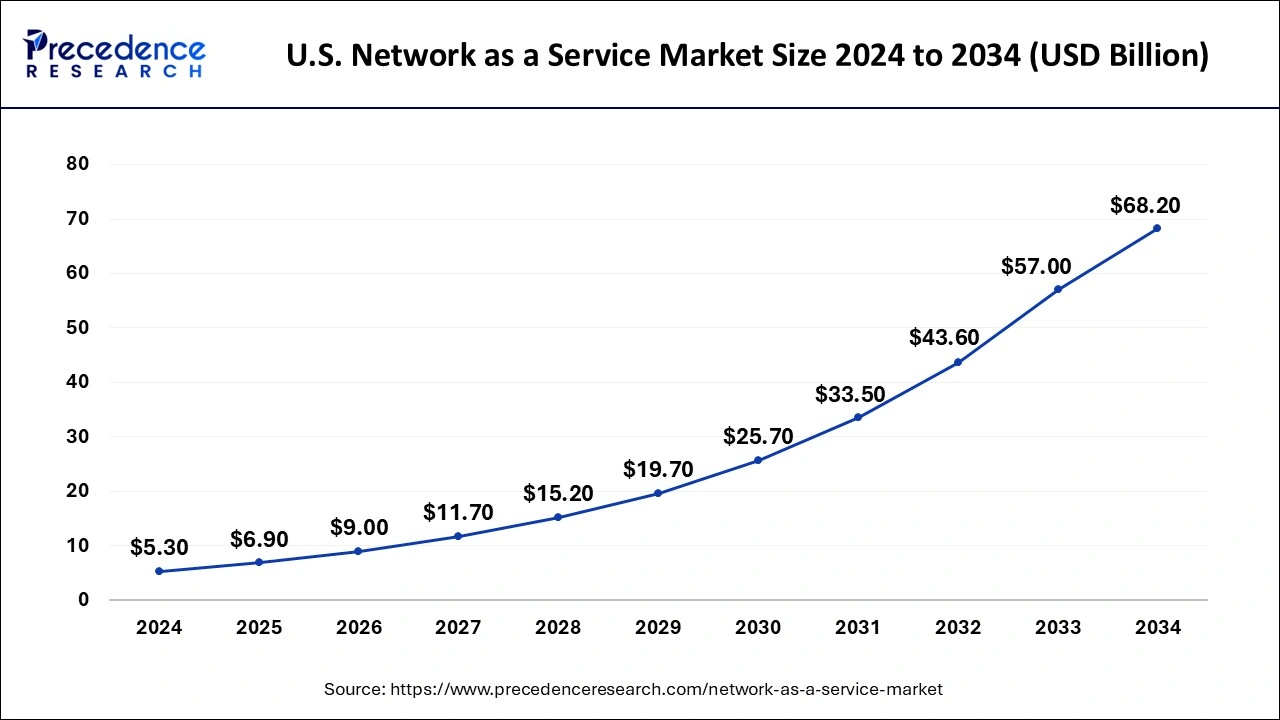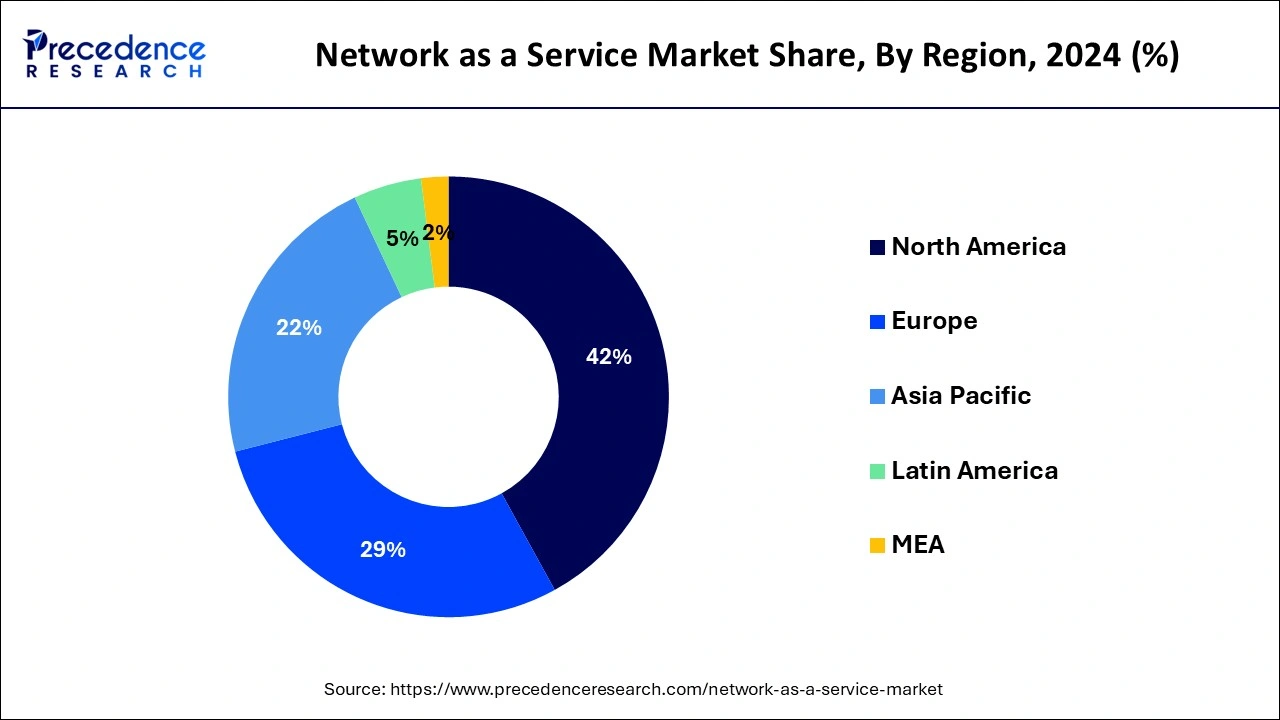February 2025
The global network as a service market size is calculated at USD 23.50 billion in 2025 and is forecasted to reach around USD 230.10 billion by 2034, accelerating at a CAGR of 28.95% from 2025 to 2034. The North America network as a service market size surpassed USD 7.60 billion in 2024 and is expanding at a CAGR of 28.98% during the forecast period. The market sizing and forecasts are revenue-based (USD Million/Billion), with 2024 as the base year.
The global network as a service market size was estimated at USD 18.10 billion in 2024 and is predicted to increase from USD 23.50 billion in 2025 to approximately USD 230.10 billion by 2034, expanding at a CAGR of 28.95% from 2025 to 2034.

The U.S. network as a service market size was valued at USD 5.30 billion in 2024 and is expected to reach around USD 68.20 billion by 2034, growing at a CAGR of 29.11% from 2025 to 2034.

North America held the largest market share of 42% in 2024 due to its advanced technological infrastructure, widespread adoption of cloud services, and the presence of key industry players. The region's proactive approach toward digital transformation, coupled with a high demand for scalable and flexible networking solutions, has fueled the network as a service market’s growth. Additionally, the increasing trend of remote work and the robust IT ecosystem contribute to North America's dominant position in the NaaS market, as businesses prioritize efficient and secure network management solutions.

Asia-Pacific is poised for rapid growth in the network as a service market, due to escalating digital transformation, increasing cloud adoption, and a surge in remote work. Countries in the region are investing heavily in advanced networking technologies to support evolving business needs. Additionally, the rising demand for scalable and cost-effective network solutions is driving NaaS adoption. With a burgeoning economy, a tech-savvy population, and a focus on modernizing infrastructure, the Asia-Pacific NaaS market is well-positioned for substantial expansion.
Meanwhile, the Europe region is experiencing notable growth in the network as a service market due to several factors. The increasing adoption of cloud services, rising demand for scalable and flexible network solutions, and a focus on digital transformation are driving the expansion. Moreover, the region's emphasis on remote work and the need for efficient and secure connectivity are boosting the demand for NaaS. The evolving business landscape, coupled with the desire for cost-effective and adaptable networking solutions, contributes to the significant growth of NaaS in the European market.
Network as a service (NaaS) is a cloud-based networking solution that provides businesses with on-demand access to network resources without the need for owning or maintaining physical network infrastructure. It operates on a subscription model, allowing organizations to scale their network capabilities as needed. NaaS offers flexibility, allowing users to manage and customize their networks easily through a centralized platform.
The network as a service market offers simplified solutions for network management by outsourcing tasks like maintenance and upgrades to service providers. This model enhances efficiency and agility, enabling companies to focus on their core operations while ensuring a secure and reliable network environment. NaaS is particularly beneficial for businesses seeking cost-effective, scalable, and easily manageable networking solutions without the burden of extensive in-house infrastructure.
| Report Coverage | Details |
| Growth Rate from 2025 to 2034 | CAGR of 28.95% |
| Market Size in 2025 | USD 23.50 Billion |
| Market Size by 2034 | USD 230.10 Billion |
| Base Year | 2024 |
| Forecast Period | 2025 to 2034 |
| Segments Covered | By Type, By Enterprise Type, and By End-user |
| Regions Covered | North America, Europe, Asia-Pacific, Latin America, and Middle East & Africa |
Rise in cloud adoption
The surge in cloud adoption is propelling the growth of the network as a service market as businesses increasingly migrate their operations to cloud environments. As more organizations embrace cloud services for their data storage, applications, and computing needs, the necessity for reliable and agile network solutions becomes paramount. It offers a seamless integration with cloud infrastructures, providing businesses with the flexibility and scalability required to support their operations in the cloud.
Moreover, with 94% of enterprises in the U.S. implementing cloud services, there is a growing need for efficient and secure connectivity between on-premises networks and diverse cloud platforms. NaaS simplifies this complex network management, enabling businesses to optimize their connectivity, enhance performance, and ensure a seamless transition to the cloud. The rising demand for NaaS in the context of increasing cloud adoption underscores its pivotal role in modernizing network architectures to meet the evolving demands of a cloud-centric business landscape.
Dependency on internet connectivity
The dependency on internet connectivity poses a notable restraint for the growth of network as a service market. As network as a service relies heavily on the internet for seamless network operations, any disruptions or outages in internet connectivity can directly impact the performance and reliability of the network. This vulnerability makes organizations cautious about fully embracing NaaS, particularly in regions where internet infrastructure is inconsistent or unreliable.
Furthermore, concerns about the stability of internet connections raise questions about the dependability of NaaS for mission-critical applications. Businesses, especially those with stringent requirements for uninterrupted operations, may hesitate to fully commit to NaaS solutions due to the potential risks associated with relying on external networks. Addressing these challenges and ensuring robust backup measures could be crucial for NaaS providers to mitigate the impact of internet connectivity dependency and boost confidence in the market.
AI and automation integration
The integration of artificial intelligence (AI) and automation is creating significant opportunities for the network as a service market to expand. By incorporating AI-driven optimizations and automated processes, NaaS providers can enhance the efficiency and intelligence of network management. AI algorithms analyze data in real-time, enabling predictive maintenance, proactive issue resolution, and dynamic network adjustments. This not only streamlines operations but also improves the overall performance and responsiveness of NaaS solutions.
Moreover, automation plays a pivotal role in simplifying complex network tasks, reducing manual intervention, and ensuring faster response times. NaaS providers leveraging AI and automation can offer more adaptive, self-learning networks that align with the dynamic demands of modern businesses.
The WAN as a service segment held the highest market share of 53% in 2024. WAN as a service (WaaS) is a segment within the network as a service market that specifically focuses on delivering Wide Area Network (WAN) capabilities as a scalable and subscription-based service. This solution allows businesses to access and manage their wide-area network infrastructure without the need for extensive physical hardware. Recent trends indicate a growing demand for WaaS due to its ability to provide secure and efficient connectivity across geographically dispersed locations, aligning with the increasing prevalence of remote work and the need for seamless interconnectivity.
The LAN as a service segment is anticipated to witness rapid growth at a significant CAGR of 18.7% during the projected period. LAN as a service (LANaaS) is a segment within the network as a service market that provides businesses with a cloud-based Local Area Network solution. It enables organizations to access and manage their local networks through a subscription model, eliminating the need for extensive on-premises infrastructure. A key trend in LANaaS is the growing adoption of virtual LANs, enhancing network flexibility and scalability. This allows businesses to optimize their local network resources efficiently, accommodating the evolving connectivity needs of modern workplaces in a cost-effective manner.
The large enterprise segment has held a 56% market share in 2024. Large enterprises, within the context of the network as a service market, refer to sizable organizations with extensive networking needs. These enterprises typically operate on a broad scale, requiring robust and scalable network solutions. A trend in this segment involves the increasing adoption of NaaS to address complex networking requirements, providing these enterprises with flexible, cost-effective, and secure solutions. Large enterprises leverage NaaS to optimize network management, enhance connectivity, and adapt to evolving technological landscapes, aligning with their need for advanced, tailored networking services.
The small and medium-sized enterprise segment is anticipated to witness rapid growth over the projected period. Small and Medium-sized Enterprises (SMEs) in the network as a service market, refer to businesses with relatively smaller scales of operation. These enterprises typically have more streamlined networking needs but seek cost-effective and scalable solutions. A notable trend in the SME segment is the increasing adoption of NaaS to enhance network flexibility and efficiency. As SMEs strive for digital transformation, NaaS offers a viable option to optimize network resources without the need for extensive in-house infrastructure, aligning with the resource constraints often faced by smaller enterprises.
The corporate customers segment held a 59% revenue share in 2024. NaaS solutions often come with centralized management capabilities, allowing corporate consumers to efficiently oversee and control their entire network infrastructure from a unified platform. This centralized approach simplifies network management and enhances operational efficiency.
The individual customers segment is anticipated to witness rapid growth over the projected period. Individual customers in the network as a service market refer to end-users seeking personalized networking solutions for their home or small-scale needs. A notable trend in this segment involves the increasing demand for affordable, user-friendly NaaS offerings that cater to individual residences and small businesses. With the rise of remote work and digital activities, there's a growing emphasis on NaaS solutions that provide seamless connectivity, security, and ease of use for individual customers, reflecting a shift towards decentralized and accessible networking solutions.
By Type
By Enterprise Type
By End-user
By Geography
For inquiries regarding discounts, bulk purchases, or customization requests, please contact us at sales@precedenceresearch.com
No cookie-cutter, only authentic analysis – take the 1st step to become a Precedence Research client
February 2025
November 2024
January 2025
November 2024